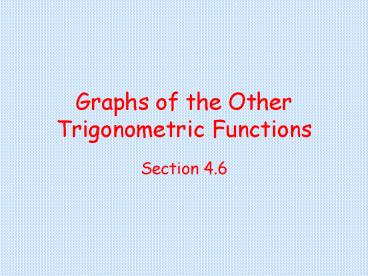Graphs of the Other Trigonometric Functions - PowerPoint PPT Presentation
1 / 20
Title:
Graphs of the Other Trigonometric Functions
Description:
Graphs of the Other Trigonometric Functions Section 4.6 – PowerPoint PPT presentation
Number of Views:57
Avg rating:3.0/5.0
Title: Graphs of the Other Trigonometric Functions
1
Graphs of the Other Trigonometric Functions
- Section 4.6
2
Objectives
- Determine the period and phase shift of the graph
of a tangent, cotangent, secant, or cosecant
function given an equation. - Match a graph to its equation.
- Determine the domain, range, asymptotes, period
and phase shift of the graph of a tangent,
cotangent, secant, or cosecant function given a
graph. - Draw the graphs of a tangent, cotangent, secant,
or cosecant function. - Determine if the sine, cosine, tangent,
cotangent, secant, or cosecant functions are
even, odd, or neither.
3
General Function
4
Graph the function tan(x) on the interval ?2p,
2p
What is the period?
p
What is the phase shift?
none in the basic function
What is the domain?
The domain is defined everywhere that the cos(x)
is not equal to 0.
continued on next slide
5
Graph the function tan(x) on the interval ?2p,
2p
What is the range?
(-8, 8)
Are there any asymptotes? If yes, what are
they?
There are many (an infinite number) of
asymptotes. They occur anywhere that the cos(x)
equals 0. Thus the asymptotes are
continued on next slide
6
Graph the function tan(x) on the interval ?2p,
2p
Is the function even, odd or neither?
The tangent function is an odd function. Thus
tan(-x) -tan(x). In terms of the graph, if you
rotate the graph 180 degrees, you get a new graph
that looks exactly like the original.
rotated 180 degrees
original
7
Graph the function cot(x) on the interval ?2p,
2p
What is the period?
p
What is the phase shift?
none in the basic function
What is the domain?
The domain is defined everywhere that the sin(x)
is not equal to 0.
continued on next slide
8
Graph the function cot(x) on the interval ?2p,
2p
What is the range?
(-8, 8)
Are there any asymptotes? If yes, what are
they?
There are many (an infinite number) of
asymptotes. They occur anywhere that the sin(x)
equals 0. Thus the asymptotes are
continued on next slide
9
Graph the function cot(x) on the interval ?2p,
2p
Is the function even, odd or neither?
The cotangent function is an odd function. Thus
cot(-x) -cot(x). In terms of the graph, if you
rotate the graph 180 degrees, you get a new graph
that looks exactly like the original.
rotated 180 degrees
original
10
General Function
11
Graph the function sec(x) on the interval ?2p,
2p
What is the period?
2p
What is the phase shift?
none in the basic function
What is the domain?
The domain is defined everywhere that the cos(x)
is not equal to 0.
continued on next slide
12
Graph the function sec(x) on the interval ?2p,
2p
What is the range?
(-8, -1 ? 1, 8)
Are there any asymptotes? If yes, what are
they?
There are many (an infinite number) of
asymptotes. They occur anywhere that the cos(x)
equals 0. Thus the asymptotes are
continued on next slide
13
Graph the function sec(x) on the interval ?2p,
2p
Is the function even, odd or neither?
The secant function is an even function. Thus
sec(-x) sec(x). In terms of the graph, if you
reflect the graph over the y-axis, you get a new
graph that looks exactly like the original.
reflected over y-axis
original
14
Graph the function csc(x) on the interval ?2p,
2p
What is the period?
2p
What is the phase shift?
none in the basic function
What is the domain?
The domain is defined everywhere that the sin(x)
is not equal to 0.
continued on next slide
15
Graph the function csc(x) on the interval ?2p,
2p
What is the range?
(-8, 8)
Are there any asymptotes? If yes, what are
they?
There are many (an infinite number) of
asymptotes. They occur anywhere that the sin(x)
equals 0. Thus the asymptotes are
continued on next slide
16
Graph the function csc(x) on the interval ?2p,
2p
Is the function even, odd or neither?
The cosecant function is an odd function. Thus
csc(-x) -csc(x). In terms of the graph, if you
rotate the graph 180 degrees, you get a new graph
that looks exactly like the original.
rotated 180 degrees
original
17
Graph
You should be able to graph this on your
calculator. You should note the vertical stretch
by a factor of 2 and the change in the period.
The new period is found based on the basic
tangent graph equation.
For our problem B is 1/4
18
Graph
To graph this on your calculator you would need
to type in either Y1 (1/2)(1/tan(x) OR Y1
(1/2)(cos(x)/sin(x)) You should note the
vertical shrink by a factor of ½ cause by the A
from the general form of the cotangent equation.
19
Graph
in order to graph this equation on your
calculator, you would need to graph Y1
2(1/sin(x)) or just Y1 2/sin(x)
The general form of the cosecant function
equation is below
The A will affect the range of the function.
The 2 in the problem will cause the function to
be vertically stretched by a factor of 2 away
from the x-axis. This will also stretch the
range by a factor of 2 away from the x-axis.
This will give a new range of (-8, -2 ? 2, 8).
20
Graph
You should be able to graph this on your
calculator. You should note the phase shift.
The new graph will be shifted to the right. How
far it is shifted is found based on the basic
tangent graph equation.































